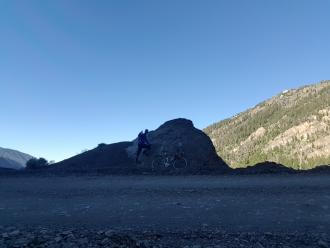Analyzing Cycles
Submitted by Justin Frost on Mon, 2017-07-10 00:00
Cycles directly control the flow of water, carbon, nitrogen and life. The water cycle is influenced by various biotic and abiotic factors, from snowpack to public policy. Personally, the effects of natural cycles also affect my ability... to cycle. My first encounter with the Boise watershed was in Featherville, just north of Anderson Ranch in the Upper Basin of the Boise watershed. The Upper Basin is the primary source of precipitation and storage to the Treasure Valley, capturing up to 500% more water each year when compared to the Lower Basin (according to research from MILES). The goal was to travel from Featherville to Ketchum using FS 227, though Pat from the Featherville Cafe informed me that the road was washed out due to the exceptional snowpack from winter. The influence of snowpack directly affected the ability to recreate in the Boise watershed, with the abiotic factors of water and geology causing a disruption in the human influence of roads and infrastructure. Trying to navigate nature creates challenges when unpredictable changes in climate create barriers, particularly in the relative wild of the Upper Basin. If we try to create infrastructure within the area of influence of the Boise watershed then we must understand how biotic and abiotic factors converge to influence the ecology of the watershed. Attached is a photo from cycling Trail Creek Summit, on the Eastern fringe of the Sawtooth National Forest, part of the Trail Creek watershed.
To digital-learners... how does the Boise watershed affect your ability to recreate? Have you all encountered obstacles cycling, camping, kayaking, rafting or fishing?


Comments
Recreation
Hi Justin,
This summer I went on a rafting trip down the Salmon river in Riggins, ID. We happened to go on opening weekend when several of the guides had not been out on that section of the river yet. The river was flowing at 80,000 CFUs (compared to a normal ~50,000 CFUs. The guides noted how they encountered the same obstacles that had always been there, but the obstacles were all slightly alterted by the enormous amount of water flowing into the valleys from snow melt. The guides used previous experiences and knowledge of the river to navigate through the waters in a safe, but exciting manner. With our environment constantly (and faster now more than ever), we, as well as all other biotic factors in the environment are forced to change and adapt by using the information presented to us and all other information we have been able to acquire over the years to find the best course of action. We can only continue to adapt with our ever-changing environment, or we will be left behind.
Thanks for sharing, Shannon!
Thanks for sharing, Shannon! We modeled some streamflow projections in Hells Canyon and predicted how the rapids may respond to changes in snowpack and precipitation. It is incredible how many agencies track and predict this data! The following link, https://climatetoolbox.org/tool/Future-Streamflows is a radical resource. Happy predicting!